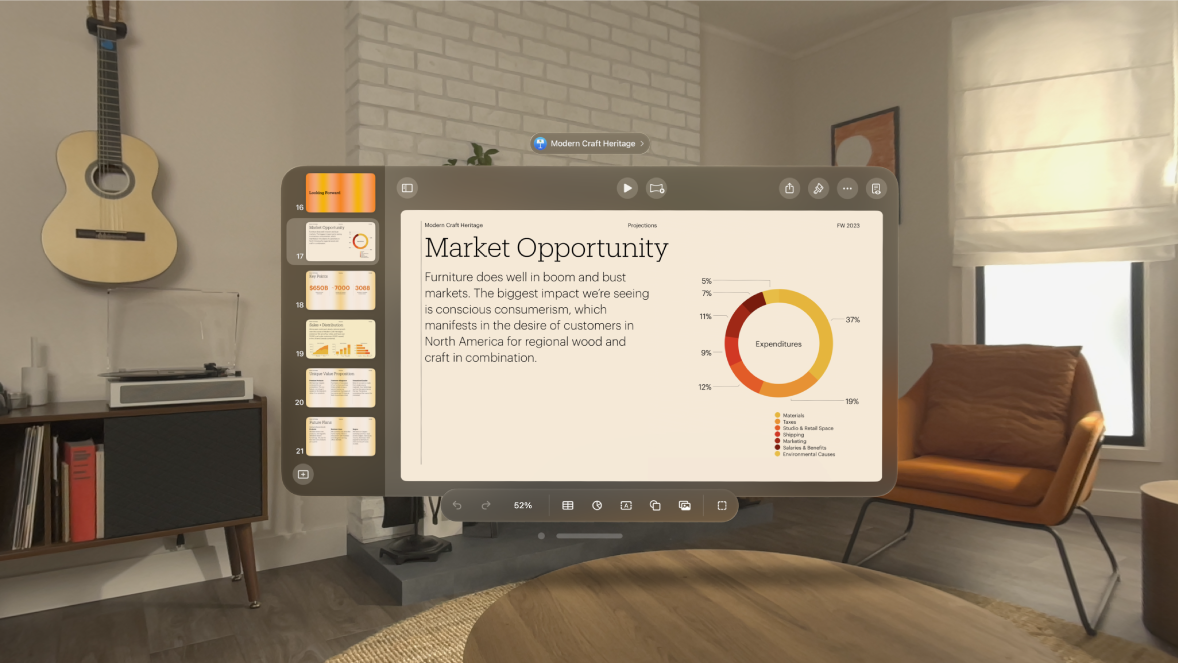Apple Vision Pro User Guide
- Welcome
- Let others use your Apple Vision Pro
-
- Capture
- Clock
- Encounter Dinosaurs
- Mindfulness
- Numbers
- Pages
- Shazam
- Shortcuts
- Tips
-
- Use built-in privacy and security protections
- Keep your Apple ID secure
-
- Sign in with passkeys
- Sign in with Apple
- Automatically fill in strong passwords
- Change weak or compromised passwords
- View your passwords and related information
- Use shared password groups
- Share passkeys and passwords securely with AirDrop
- Make your passkeys and passwords available on all your devices
- Automatically fill in verification codes
- Sign in with fewer CAPTCHA challenges on Apple Vision Pro
- Manage two-factor authentication for your Apple ID
- Create and manage Hide My Email addresses
- Protect your web browsing with iCloud Private Relay
- Use a private network address
- Use Contact Key Verification on Apple Vision Pro
- Copyright
Add a legend, gridlines and other markings in Keynote on Apple Vision Pro
There are several types of chart markings and axis labels you can add to your charts. You can modify their look to emphasize your data, and you can style the chart title and value label text differently to make it stand out from the other text.

Add a legend
Tap the chart, tap

Tap the chart, then do any of the following:
Change the style of the legend text: Tap

Reposition the legend: Pinch and drag the legend to where you want it.
Modify axis lines and gridlines
Axis lines define the edge of the chart, sometimes also marking the zero value, like an inner border. Evenly spaced gridlines cross the chart and provide a visual reference for large increments in the values. You can specify whether to show chart axis lines and gridlines and modify their look.
Tap the chart, then tap

Tap Style, tap Gridlines, then do any of the following:
Set the axis line type: Tap Line Type, then select a solid, dashed or dotted line type.
If you’re working with a radar chart, you can also tap Radial Lines (below Category) and select a line type.
Set the axis line colour: Tap the colour well, then choose a colour.
Set the axis line width: Type a value, or tap the – or + button.
Set the number and look of major gridlines: Tap Major Gridlines for the Value or Category axis. Turn on Gridlines. Next to Major Steps, type a value or tap the – or + button to adjust. You can also define the line type, colour and width and add a shadow.
Set the number and look of minor gridlines: Tap Minor Gridlines for the Value or Category axis. Turn on Gridlines. Next to Minor Steps, type a value or tap the – or + button to adjust. You can also define the line type, colour and width and add a shadow.
Show tick marks: Tap Tick Marks, then choose whether tick marks are inside, outside or centred.
Extend radial lines (for radar charts): Turn on Extend Radial Lines.
Note: These options vary depending on the type of chart and data.
To remove gridlines, tap

Show or remove reference lines
You can add reference lines to a chart to mark the average, median, minimum or maximum values. Reference lines make a chart easier to interpret at a glance and can help you compare the values in the chart to a benchmark value.
All chart types can have reference lines except stacked charts, 2-axis charts, 3D charts, pie charts, doughnut charts and radar charts. A chart can have up to five reference lines.
Tap the chart, tap

Tap Add Reference Line, then tap an option, such as Average, Minimum or Custom.
To clarify what the reference line represents, tap to turn on Show Name and Show Value.
To change the settings for a reference line, tap the name of the line, then use the controls in the panel.
You can hide, show and change the line’s name or value, change its style and colour, and add a shadow.
To remove a reference line, tap the chart to select it, tap 
Note: When you drag the slider on an interactive chart to view different data sets, its reference lines move.
Show or remove error bars
Error bars give you a general impression of your data’s accuracy. They’re represented as small marks whose length indicates the amount of uncertainty associated with a given data series (the data’s variability). You can add them to 2D line charts, area charts, bar and column charts, stacked bar and column charts, bubble charts and scatter charts.
Tap the chart, tap

Tap Error Bars, then choose an option.
Use the controls to change the look of the error bars.
To remove error bars, tap Error Bars, then choose None.
Show or remove trendlines
Trendlines show you the overall direction (or trend) of your data. Trendlines appear in bar, line, scatter, bubble, column and area charts.
Tap the chart, tap

Tap Trendlines, then choose the type of line you want to add.
Use the controls to change the look of the trendline.
To remove trendlines, tap the chart, tap 